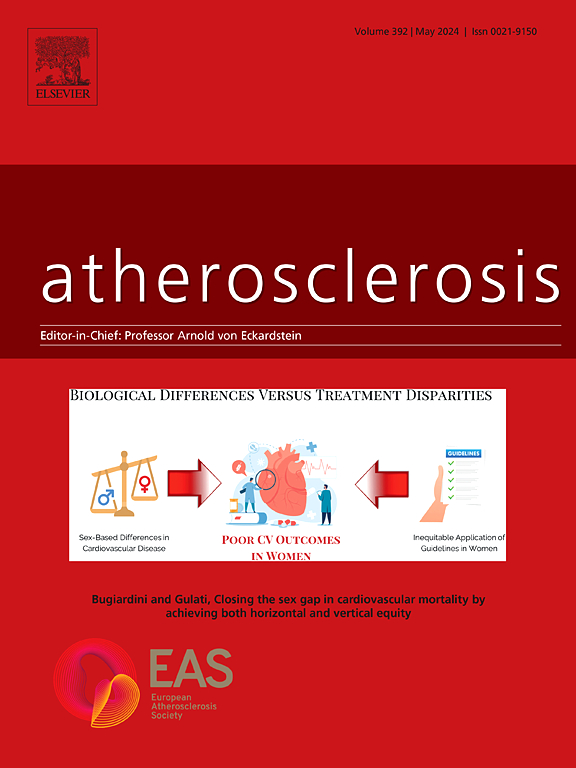迷你基因剪接报告试验:家族性低脂蛋白血症基因诊断的高风险工具
IF 5.7
2区 医学
Q1 CARDIAC & CARDIOVASCULAR SYSTEMS
引用次数: 0
摘要
背景,家族性低脂蛋白血症1 (FHBL-SD2)是原发性低胆固醇血症最常见的单基因形式,与编码载脂蛋白b的APOB基因的截短变异有关。由于其高度复杂性,不确定意义变异(VUS)需要进一步研究。本研究旨在证明设置基因检测在FHBL-SD2基因诊断中的价值。方法分析FHBL-SD2表型患者发生的4例APOB VUS。用六个软件程序进行了硅分析,以预测潜在的剪接效应。然后,使用迷你基因剪接报告实验研究了体外功能影响。结果预测了4个突变体剪接的影响,c.694-13A>;G和c.1471-6A>;G突变体的一个隐受体位点被激活,c.1123A>;G和c.1470G>; a突变体的一个隐供体位点被激活。Minigene研究显示3个突变对剪接有完全影响,证实了在计算机上的预测。所有这些转录本都会导致过早截断的变体。因此,这些变异被重新归类为FHBL-SD2的可能致病和致病因素。然而,c.1470G>;A变体在HeLA和HuH7细胞中均未显示出影响。结论minigene研究有望提高FHBL-SD2的诊断准确性。它强调了在解释自愿自愿行为方面的挑战,并强调了制定明确战略以评估其重要性的重要性。因此,促进迷你基因研究将有助于准确理解剪接变异体的影响。本文章由计算机程序翻译,如有差异,请以英文原文为准。

Minigene splicing reporter assay: a high-stake tool for genetic diagnosis in familial hypobetalipoproteinemia
Background & aims
Familial hypobetalipoproteinemia 1 (FHBL-SD2) is the most common monogenic form of primary hypocholesterolaemia, related to truncating variants in the APOB gene encoding apolipoprotein B. Due to its high level of complexity, variants of uncertain significance (VUS) require further investigations. This study aims to demonstrate the value of setting minigene assays in the FHBL-SD2's genetic diagnosis.
Methods
Four APOB VUS occurring in patients with a FHBL-SD2 phenotype were considered. In silico analysis were performed with six software programs supposed to predict the potential splicing effect. Then, functional consequences were studied in vitro using a minigene splicing reporter assay.
Results
An effect on splicing was predicted in silico for the 4 variants, with the activation of a cryptic acceptor site for c.694-13A>G and c.1471-6A>G variants, and the use of a cryptic donor site for c.1123A>G and c.1470G>A variants. Minigene study showed a complete effect on splicing for 3 mutations, confirming the in silico predictions. All of these transcripts result in premature truncated variants. Therefore, these variants were reclassified as likely pathogenic and causative of FHBL-SD2. However, no effect was shown either in HeLA and HuH7 cells for the c.1470G>A variant.
Conclusions
Minigene study appears to be a promising and valuable tool to enhance the diagnostic accuracy of FHBL-SD2. It emphasizes the challenge in interpreting VUS and underscores the importance of establishing a clear strategy to assess their significance. Therefore, promoting minigene studies would be beneficial to understand precisely the impact of splicing variants.
求助全文
通过发布文献求助,成功后即可免费获取论文全文。
去求助
来源期刊

Atherosclerosis
医学-外周血管病
CiteScore
9.80
自引率
3.80%
发文量
1269
审稿时长
36 days
期刊介绍:
Atherosclerosis has an open access mirror journal Atherosclerosis: X, sharing the same aims and scope, editorial team, submission system and rigorous peer review.
Atherosclerosis brings together, from all sources, papers concerned with investigation on atherosclerosis, its risk factors and clinical manifestations. Atherosclerosis covers basic and translational, clinical and population research approaches to arterial and vascular biology and disease, as well as their risk factors including: disturbances of lipid and lipoprotein metabolism, diabetes and hypertension, thrombosis, and inflammation. The Editors are interested in original or review papers dealing with the pathogenesis, environmental, genetic and epigenetic basis, diagnosis or treatment of atherosclerosis and related diseases as well as their risk factors.
 求助内容:
求助内容: 应助结果提醒方式:
应助结果提醒方式:


